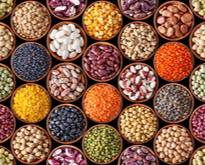Pulses have been a staple food in diets across the globe for millennia. They include field peas, broad and field beans, sweet lupins, chickpeas and lentils. They are an important source of protein and other nutrients, which can supplement meat and dairy products. Furthermore, due to the nitrogen-fixing properties of legumes (the plants from which pulses are produced), their cultivation reduces dependence on synthetic fertilizers and at the same time improves soil fertility. Recognising their significance, the United Nations General Assembly proclaimed 2016 as the International Year of Pulses and, since 2019, 10 February as World Pulses Day.
The latest Eurostat data show that the total production of pulses in the EU was 4 110 thousand tonnes in 2018. The total area devoted to the cultivation of pulses in the EU was 2 170 thousand hectares - to put this into perspective, this area is only 10% smaller than the island of Sardinia.
The EU Member States with the largest production of pulses in 2018 were France (840 thousand tonnes), Spain (690 thousand tonnes), Poland (460 thousand tonnes), Germany (400 thousand tonnes) and Lithuania (380 thousand tonnes). These five countries together accounted for 67% of total EU production in 2018.
Source dataset: apro_cpsh1
Note: The European Union (EU) includes 27 EU Member States. The United Kingdom left the European Union on 31 January 2020. Further information is published here.
To contact us, please visit our User Support page.
For press queries, please contact our Media Support.


